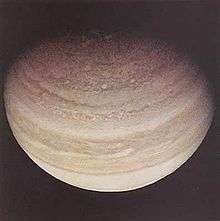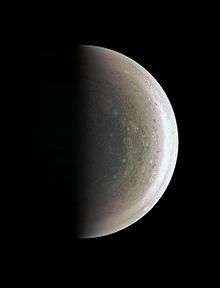JunoCam



JunoCam (or JCM) is the visible-light camera/telescope of the Juno Jupiter orbiter, a NASA space probe to the planet Jupiter launched on 5 August 2011. It was built by Malin Space Science Systems.[1]
JunoCam is not one of the probe's core scientific instruments; it was put on board to increase public engagement, and all images will be available on NASA's website.[2]
Due to telecommunications constraints, Juno will only be able to return about 40 megabytes of camera data during each 11-day orbital period. This downlink average data rate of around 325 bits per second will limit the number of images that are captured and transmitted during each orbit to somewhere between 10 and 1000 depending on the compression level used.[3] This is comparable to the previous Galileo mission that orbited Jupiter, which captured thousands of images[4] despite its slow data rate of 1000 bits per second (at maximum compression levels) due to antenna problems that crippled its planned 135,000 bit-per-second communications link.

Design origins
The JunoCam physical and electronic interfaces are largely based on the MARDI instrument for the Mars Science Laboratory.[1] However, the housing and some aspects of the camera's inner mechanism have been modified to provide stable operation in the planet's comparatively intense radiation and magnetic field.[1] Part of its mission will be to provide close up views of Jupiter's polar region and lower-latitude cloud belts,[1] and at Juno's intended orbit the camera is able to take images at up to 15 kilometres (9.3 mi) per pixel resolution.[1]
Interfaces
The camera is run by the JunoCam Digital Electronics Assembly (JDEA) also made by MSSS.[1] The JunoCam is physically mounted to the body of the spacecraft, and moves with the spacecraft. The Voyager cameras (that also imaged Jupiter) were the only spacecraft cameras that were movable.
Specifications
The camera and the mission are not designed to study the moons of Jupiter.[5] Only the poles and atmosphere of Jupiter will be imaged with high resolution. JunoCam has a field of view that is too wide to resolve any detail in the Jovian moons beyond 232 kilometers per pixel. Jupiter itself will only appear to be 75 pixels across from JunoCam when Juno reaches the furthest point of its orbit around the planet.[3] At its closest approaches JunoCam could achieve 15 km/pixel resolution from 4300 km, while Hubble has taken images of up to 119 km/pixel from 600 million km.[6]
The camera uses a Kodak image sensor, the KODAK KAI-2020, capable of color imaging at 1600 x 1200 pixels: less than 2 megapixels. [7] It has a field of view of 58 degrees with four filters (red, green, blue, and a methane band) to provide color imaging.[8] The low resolution, rigid mounting and lossy compression, applied before transmission makes it effectively the Juno dashcam.
Despite the intense magnetosphere of Jupiter, the JunoCam is expected to be operational for at least the first eight orbits.[9] Since the orbital period is 53 days for the first two orbits and 14 days for the subsequential orbits, this means that the camera is expected to function until January 11, 2017.
Jovian Infrared Auroral Mapper
In 2005 the Italian Space Agency (ASI) proposed an additional visible light instrument 'ItaCam', but instead they built a near-infrared camera/spectrometer, "Jovian Infrared Auroral Mapper" (JIRAM) and a Ka-band transponder.[5] ASI previously contributed a near-infrared instrument to the Cassini–Huygens Saturn probe.[5]
See also
- Galileo (spacecraft), NASA space probe to Jupiter 1989–2003.
Other cameras manufactured by Malin Space Science Systems:
- Mars Color Imager for the Mars Reconnaissance Orbiter (MRO) spacecraft
- Context (CTX) Camera also for the MRO spacecraft
- Mars Orbiter Camera
References
- 1 2 3 4 5 6 "Malin Space Science Systems - Junocam, Juno Jupiter Orbiter". Retrieved 2016-07-17.
- ↑ "Juno Spacecraft Captures 1st Photo from Jupiter Orbit". Retrieved 2016-07-17.
- 1 2 Junocam will get us great global shots down onto Jupiter's poles (The Planetary Society)
- ↑ Galileo Legacy Site Image Gallery (NASA)
- 1 2 3 Bruce Moomaw, Juno Gets A Little Bigger With One More Payload For Jovian Delivery, 2007
- ↑ Collision leaves giant Jupiter bruised - NASA, ESA, Michael Wong (Space Telescope Science Institute, Baltimore, MD), H. B. Hammel (Space Science Institute, Boulder, CO) and the Jupiter Impact Team (accessed September 25th 2010)
- ↑ Photexels - JunoCam Uses Kodak Image Sensor To Capture Jupiter (August 5, 2011)
- ↑ JunoCam: Juno's Outreach Camera (PDF)
- ↑ "Understanding Juno's Orbit: An Interview with NASA's Scott Bolton". Universe Today. Retrieved 6 February 2016.
External links
- MSSS JunoCam for Juno Jupiter Orbiter
- Big Dipper (Ursa Major) by JunoCam
- Earth flyby pics (B&W and color)
- Earth flyby pics (raw)
- Earth flyby pic (B&W)